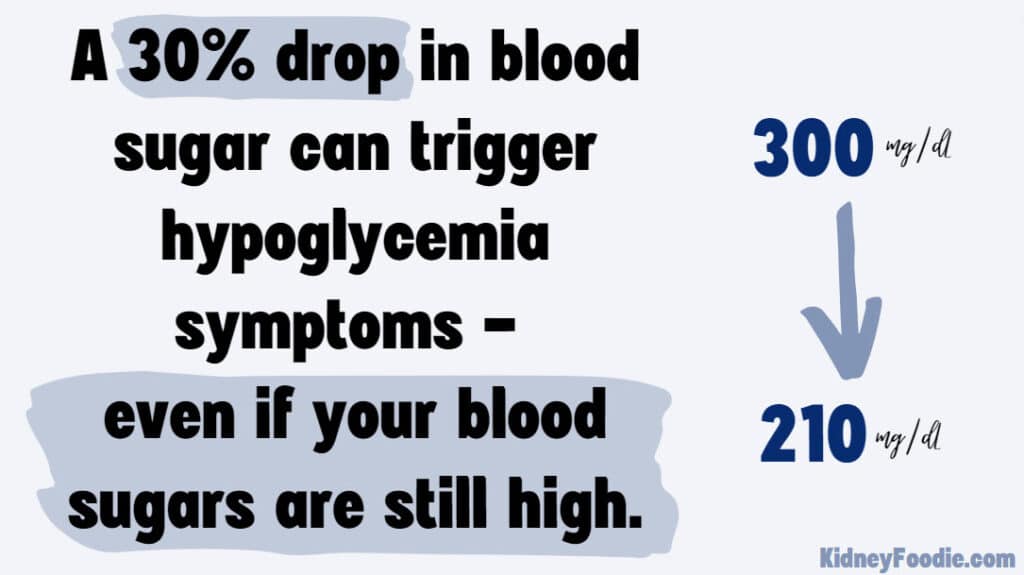If you have Chronic Kidney Disease and diabetes, you probably know how important it is to control your diabetes to help prevent further damage to your kidneys (HINT – it is VERY important).
This post may contain affiliate links through which we may earn a small commission to help keep this website free.
Unfortunately, people with diabetes who attempt to quickly get their diabetes under control can end up feeling worse than they did with high blood sugars! This can be VERY frustrating and demoralizing. If this sounds like you, then you might be experiencing pseudohypoglycemia.
Table of Contents
What is pseudo-hypoglycemia?
Pseudohypoglycemia occurs when you feel like you have hypoglycemia, but your actual blood sugar levels are normal – or even high! This is sometimes referred to as relative hypoglycemia, false hypoglycemia, or a false low.
We recommend that people always check their blood sugar levels when they feel symptoms of hypoglycemia to verify that they truly have hypoglycemia. Treating pseudohyperglycemia the same way you would treat true hypoglycemia can make it difficult to meet your diabetes goals.
What causes pseudo-hypoglycemia?
The most common cause of pseudohypoglycemia is a large decrease in blood sugar level compared to what a person is accustomed to.
For example, if your blood sugar levels are usually around 300mg/dL and then your blood sugar drops to 210mg/dL, this would be a significant drop in blood sugar compared to your normal level. For some people, their body will react as if they have true hypoglycemia – even though 210mg/dL is considered a high blood sugar level, certainly nowhere near a true hypoglycemia level of 70mg/dL.
For people with chronically elevated blood sugar levels, their body has created a new set-point or threshold for what it thinks hypoglycemia is. Research has found that a 30% drop in blood sugar level from your setpoint can trigger hypoglycemia symptoms – even if your blood sugar is still high.

A similar phenomenon happens with your body’s temperature. I’m from the south where heat waves are common. If you spend time outside in 105 degree weather and then walk into a room that is 90 degrees, that room is going to feel really cool to you. But if you were sitting in a nice, air conditioned 70 degree room and then walked outside to a 90 degree day, then you would think it was hot outside! It is all relative to what your body is used to (which is why we sometimes also call pseudohypoglycemia ‘relative hypoglycemia’).
How do you treat pseudo-hypoglycemia?
There are a few things to consider when dealing with pseudo-hypoglycemia.
The first thing to consider is what is causing the significant drop in blood sugar? Was a new diabetes medication prescribed? Was the dose of a diabetes medication increased? Did you make significant changes to your diet or meals?
Whatever the change was, you may need to make a more gradual change. It can be tempting to want to see results fast because you know how beneficial it is for your kidneys, but if you experience pseudo-hypoglycemia and constantly feel rotten due to the symptoms, then you probably won’t want to stick with the change for very long.
Making more gradual changes to your diabetes treatment plan will allow your body to adapt to lower blood sugar levels without triggering feelings of hypoglycemia. We don’t want you to feel worse when making positive changes to your lifestyle.

A second thing to consider is how to treat the pseudohypoglycemia when it happens. For true hypoglycemia where blood sugar levels are below 70mg/dL, it is recommended to take 15g of rapid acting carbohydrate to get blood sugar levels up.
With pseudohypoglycemia, your body does not need to raise blood sugar levels to prevent the dangers of hypoglycemia like seizure, but we do need to alleviate the uncomfortable symptoms that you are feeling.
Eating carbohydrates will help alleviate the symptoms but will raise your blood sugar even higher. In these circumstances, you would want to try eating a smaller amount of carbohydrate such as 5g of rapid acting carbohydrate to see if that is enough to relieve symptoms. If you are hungry, then following the small amount of fast acting carbohydrates with a well-balanced snack or meal would be appropriate.
If you treat your pseudohypoglycemia with too many fast-acting carbohydrates, it may raise your blood sugar too much and prevent you from making progress towards your diabetes goals.
If pseudohypoglycemia is happening frequently, talk to your healthcare provider about adjusting your medications so that you make more gradual progress towards your target blood sugars and A1C, allowing your body to adjust.
Want to learn more about managing diabetes and CKD? Check out our CKD + Diabetes Nutrition Course!
Reference:
Aboona, F., Zahedi, S., & Reddy, S. S. K. (2019). Pseudohypoglycemia. In M. T. McDermott (Ed.), Management of Patients with Pseudo-Endocrine Disorders: A Case-Based Pocket Guide (pp. 99–107). Springer International Publishing. https://doi.org/10.1007/978-3-030-22720-3_9
